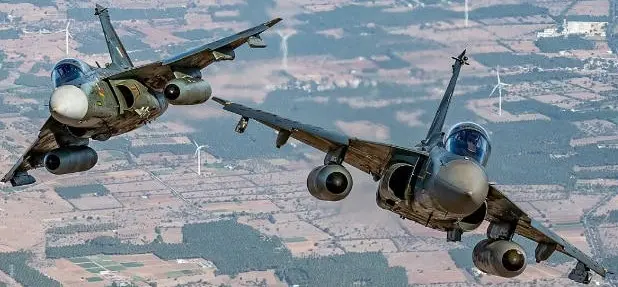
Wings of Victory: Tejas Mk1A Deal Signals India’s Soaring Leap in Air Defense Innovation
A Historic Leap: 97 Tejas Mk1A Jets to Reinforce Indian Air Force
Tejas Mk1A Deal Propels India’s Air Power – In a landmark move that underscores India’s growing self-reliance in defense manufacturing, the Indian Air Force (IAF) has signed a monumental deal with Hindustan Aeronautics Limited (HAL) for the procurement of 97 Tejas Mk1A fighter jets, valued at approximately ₹60,000 crore. This agreement marks one of the largest indigenous defense acquisitions in Indian history and is expected to significantly bolster the IAF’s combat capabilities.
Table of Contents
The Tejas Mk1A is a 4.5-generation lightweight multirole fighter aircraft, designed to replace the aging MiG-21 fleet. With this new order, the total number of Tejas Mk1A jets in the IAF’s arsenal will rise to 180, forming the backbone of India’s tactical air defense strategy for the next decade.
This deal is not just about numbers, it’s about strategic autonomy. By investing in indigenous platforms, India is reducing its dependence on foreign suppliers and reinforcing its commitment to the “Make in India” initiative. HAL’s production facilities in Bengaluru and Nashik have already ramped up output, with 15 aircraft expected to be ready by December 2025.
DRDO’s ‘Uttam’ AESA Radar: The Indigenous Wonder Behind Tejas Mk1A’s Edge
What truly sets the Tejas Mk1A apart is the integration of DRDO’s ‘Uttam’ AESA radar, a cutting-edge technology that has redefined the aircraft’s operational capabilities. AESA, or Active Electronically Scanned Array, is a radar system that can simultaneously detect and track multiple targets—airborne, ground-based, and maritime—from over 150 kilometers away.
This radar is entirely developed in India, making it a symbol of technological prowess and strategic independence. It enables the Tejas Mk1A to:
- Detect stealth aircraft and cruise missiles
- Engage in Beyond Visual Range (BVR) combat
- Operate in electronic warfare environments
- Track multiple targets with high precision
The Uttam radar transforms the Tejas Mk1A into a deadly multirole platform, capable of both offensive and defensive operations. It’s a leap from traditional radar systems, offering faster response times, greater accuracy, and enhanced survivability in hostile environments.
In addition to the radar, the Mk1A variant features an electronic warfare suite, mid-air refueling capability, and compatibility with advanced weaponry like the Astra Mk1 BVR missile, further amplifying its combat potential.
Production Momentum: HAL’s Race Against Time
To meet the ambitious delivery schedule, HAL has restructured its production lines for maximum efficiency. The Bengaluru facility, with two operational lines, is now complemented by a third line in Nashik, which received flight clearance in August 2025. Each line is capable of producing 8 aircraft annually, with plans to scale up to 24 jets per year starting in 2026.
HAL has already delivered 10 Tejas Mk1A aircraft, with two more nearing completion and three trainer variants in the pipeline. The production acceleration was made possible after resolving supply chain bottlenecks, particularly the delayed delivery of GE Aerospace’s F404-IN20 engines, which power the Tejas Mk1A.
Private sector collaboration has also played a pivotal role, with Indian companies contributing to avionics, airframes, and subsystems. This decentralized model not only enhances production speed but also strengthens India’s defense ecosystem.
Strategic Impact: Redefining India’s Air Dominance
The Tejas Mk1A deal is more than a procurement, it’s a strategic statement. In a region marked by evolving threats and shifting alliances, India’s decision to invest in indigenous air power sends a clear message of preparedness and resilience.
With enhanced radar, advanced weaponry, and superior agility, the Tejas Mk1A is poised to:
- Strengthen border patrol and quick-response capabilities
- Replace outdated platforms with modern, versatile fighters
- Serve as a deterrent against regional adversaries
- Support joint operations with other branches of the armed forces
Moreover, the success of this program could pave the way for future exports, positioning India as a global player in defense manufacturing. Countries in Southeast Asia, Africa, and Latin America have already expressed interest in the Tejas platform, drawn by its cost-effectiveness and performance.
Final Word: A Flight Toward Sovereignty
The signing of the Tejas Mk1A deal is a defining moment in India’s defense narrative. It reflects a shift from dependency to dominance, from importing to innovating. With HAL’s production lines humming and DRDO’s technology blazing new trails, the Indian Air Force is not just acquiring jets, it’s embracing a future of sovereign strength and strategic clarity. As these aircraft take to the skies, they carry more than missiles and radars—they carry the aspirations of a nation determined to soar.